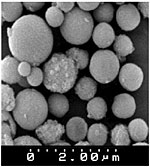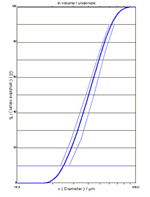As a general rule, instruments available on the
market give quick results. However, the type of instrument
used, the system accuracy, and the measurement protocol can
affect the reproducibility of the measurement. The ISO
13320-part1 standard has been developed in order to
provide the user with results that are independent of the
instrument used.
The standard requires that the manufacturer
calibrate the instrument using Certified Reference Materials
(CRMs) of a known size distribution. The user must also verify
operation of the instrument, both repeatability and accuracy,
at regular time intervals using CRMs. The main requirements of
the standard are the following:
Table 1: Summary of the main
requirements of the ISO 13320 standard.
|
Requirement |
Target values
|
Test
Method |
|
Repeatability
(6.4 in the standard)
|
Coefficient of
variation
<3% for X50
<5% for X10 & X90
(below 10Ám, these
values
should be doubled) |
The
measurement is done
on at least 5 different samples
from the same batch
|
|
Accuracy
(6.5 in the standard)
|
Maximum deviation from the certified range
:
<3% for X50
<5% for X10 &
X90
(below 10Ám,
these values
should be doubled)
|
Mean
value over
3 independent
measurements
|
Note: X50 represents
the median diameter in mm, which means 50% (by volume) of the
particles are smaller than this diameter.
The ISO13320-1 norm can be downloaded on the
ISO web site : click here
 Certified Reference
Materials (CRMs) are made of spherical particles and the size
distribution of these particles must retraced to a recognised
size standard.
Certified Reference
Materials (CRMs) are made of spherical particles and the size
distribution of these particles must retraced to a recognised
size standard.
Fig 1. SEM Picture of Certified
Glass Beads (from Whitehouse Scientific)
Data collected using
the Cilas 930L,1064L and 1180L instruments showed better
repeatability and accuracy
values than required in the ISO 13320 standard. Statistics
from over 50 production instruments have shown a
reproducibility of better than 1%.
 Fig 3. Measurement of the
10-100 m m CRM with a Cilas 1064 system
Fig 3. Measurement of the
10-100 m m CRM with a Cilas 1064 system
Cilas instruments are very
accurate because of their unique short bench design. All Cilas
systems use a permanently aligned optical bench without any
moving parts to provide superior repeatability.
The ISO 13320 standard provides the industrial
laboratory an effective method for instrument selection.
Laboratories who use the standard can guarantee the accuracy
and reproducibility of their measurements throughout the
entire life of the instrument.


